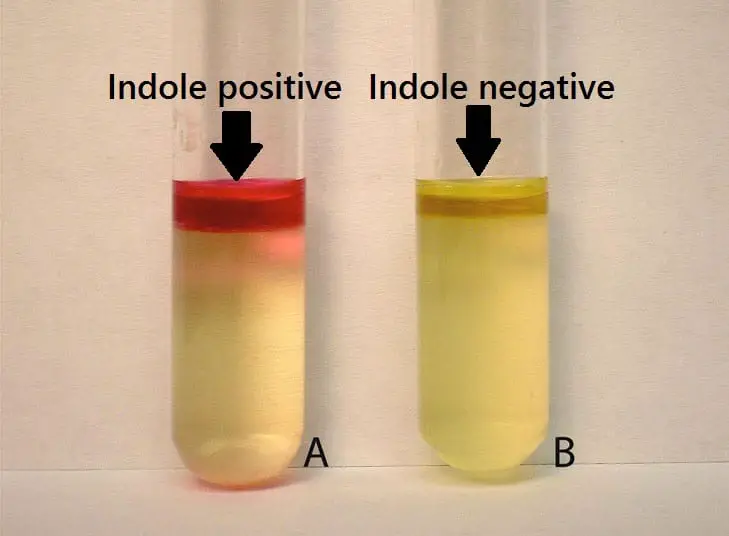Indole test is the a biochemical test performed on bacterial species to detect the ability of an organism to degrade the amino acid tryptophan and produce indole. It is used as the part of the IMViC tests, a set of four useful reactions that are commonly designed for the differentiation of enterics (members of family Enterobacteriaceae). The IMViC series includes following four tests
- Indole test
- Methyl red test
- Voges-Proskauer test
- Citrate test
Principle of Indole Test
Some bacteria split amino acid tryptophan into indole and pyruvic acid using the enzyme called tryptophanase. Indole can be detected with Kovac’s reagent or Ehrlich’s reagent. Indole reacts with the aldehyde in the reagent to give a red color which concentrates as a ring at the top.
Procedure
- Bacterium to be tested is inoculated in typtone broth.
- Incubate overnight at 37°C.
- Add few drops of Kovac’s reagent. Ehrlich’s reagent is more sensitive in
detecting indole production in anerobes and non-fermenters. - Do not shake the tube and observe the result.
Interpretation
Formation of red or pink colored ring at the top is taken as Positive.
No color change after addition of reagent is taken as Negative.
Indole positive organisms
Most strains of E.coli, P. vulgaris, M. morganii and Providenica are indole positive.
Importance
Along with differentiation of enterics, Indole test can also be used for species differentiation.
- Proteus Species: To differentiate Proteus mirabilis (indole negative) from all other Proteus species (indole positive)
- Klebsiella species: To differentiate Klebssiella pneumoniae (indole negative) from Klebsiella oxytoca (indole positive)
- Citrobacter species: To differentiate Citrobacter freundii (indole negative) from Citrobacter koseri (indole positive)
Additional Notes
Preparation of reagents :
Tryptone broth :
Tryptone = 10gm
Sodium chloride = 5gm
Dissolve the ingredients in 1 liter of sterile water. Dispense 4 ml per tube. Cap tube and autoclave at 121oC under 15 psi pressure for 15 minutes. Store the tubes in the refrigerator at 4 to 10°C.
Kovac’s reagent :
Amyl alcohol : 150ml
p-dimethylaminobenzaldehyde (DMAB) : 10gm
conc. HCl : 50ml
(Dissolve DMAB in the alcohol. Slowly add the acid to the aldehyde-alcohol mixture.)


Hi dear Dhurba
I have made 100 ml kovacs reagent but its color has turned to blue-purple instead of yellow. Do you know what is the problem with my kovacs reagent?
Thank you